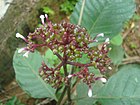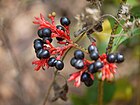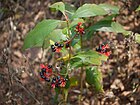Note: This is a project under development. The articles on this wiki are just being initiated and broadly incomplete. You can Help creating new pages.
Difference between revisions of "Rauvolfia serpentina - Sarpa Gandha"
(→Uses) |
(→Identification) |
||
| (11 intermediate revisions by 3 users not shown) | |||
| Line 1: | Line 1: | ||
[[File:Rauvolfia serpentina 11.JPG|thumb|right|''Sarpa Gandha'']] | [[File:Rauvolfia serpentina 11.JPG|thumb|right|''Sarpa Gandha'']] | ||
| − | |||
| − | |||
'''Rauvolfia serpentina''' is a species of flower in the family Apocynaceae. It is native to the Indian subcontinent and East Asia from India to Indonesia. | '''Rauvolfia serpentina''' is a species of flower in the family Apocynaceae. It is native to the Indian subcontinent and East Asia from India to Indonesia. | ||
| − | |||
==Uses== | ==Uses== | ||
| − | {{Uses| | + | {{Uses|High blood sugar}}, {{Uses|Lowering blood pressure}}, {{Uses|Cataract}}, {{Uses|Plague}}, {{Uses|Schizophrenia}}, {{Uses|Anxiety}}, {{Uses|Psychosis}}, {{Uses|Epilepsy}}, {{Uses|Colic}}, {{Uses|Cholera}}, {{Uses|Snake bite }}, {{Uses|Hypochondria}}, {{Uses|Mental disorders}}, {{Uses|Intractable skin disorder}}, {{Uses|Psoriasis}}. |
==Parts Used== | ==Parts Used== | ||
| − | {{Parts Used| | + | {{Parts Used|Roots}}. |
==Chemical Composition== | ==Chemical Composition== | ||
| − | Ajmaline, ajmalinine and ajmalicine, serpentine, serpentinine, alkaloids, reserpine, rescinnamine and yohimbine<ref name="chemical composition"/> | + | Ajmaline, ajmalinine and ajmalicine, serpentine, serpentinine, alkaloids, reserpine, rescinnamine and yohimbine.<ref name="chemical composition"/> |
==Common names== | ==Common names== | ||
| − | {{Common names|kn=|ml=|sa=|ta=|te=|hi=|en=Snake-root}} | + | {{Common names|kn=Sarpagandha|ml=Suvapavalforiyan|sa=Sarpagandha|ta=Chivan amelpodi|te=Paataala goni|hi=Sarpagandha|en=Snake-root}} |
==Properties== | ==Properties== | ||
| Line 40: | Line 37: | ||
===Flower=== | ===Flower=== | ||
| − | {{Flower|Unisexual|2-4cm long| | + | {{Flower|Unisexual|2-4cm long|Violet|5|Flowers are in irregular corymbose cymes, white, often tinged with violet. Flowering season is May-January}} |
===Fruit=== | ===Fruit=== | ||
| − | {{Fruit|Simple|7–10 mm| | + | {{Fruit|Simple|7–10 mm|Clearly grooved lengthwise, Lowest hooked hairs aligned towards crown||Many|Fruiting season is May-January}} |
===Other features=== | ===Other features=== | ||
| Line 58: | Line 55: | ||
==Commonly seen growing in areas== | ==Commonly seen growing in areas== | ||
| − | {{Commonly seen| | + | {{Commonly seen|Trophical region}}, {{Commonly seen|Borders of forests and fields}}. |
==Photo Gallery== | ==Photo Gallery== | ||
<gallery class="left" caption="" widths="140px" heights="140px"> | <gallery class="left" caption="" widths="140px" heights="140px"> | ||
| − | + | Amalpori buds.jpg | |
| − | + | Amalpori.jpg | |
| − | + | Chandra (Bengali- চন্দ্র) (6928674411).jpg | |
| + | Ichneumon Plant (6782553398).jpg | ||
| + | Indian Snakeroot (505583655).jpg | ||
| + | Indian Snakeroot Rauvolfia serpentina (সর্পগন্ধা) WLB DSC 0237.jpg | ||
| + | Indian snakeroot Rauvolfia serpentina WLB DSC 0242.jpg | ||
</gallery> | </gallery> | ||
| Line 70: | Line 71: | ||
<references> | <references> | ||
| − | <ref name="chemical composition">[http://www.biologydiscussion.com/medicinal-plants/rauvolfia-serpentina-habitat-history-and-constituents/51900 | + | <ref name="chemical composition">[http://www.biologydiscussion.com/medicinal-plants/rauvolfia-serpentina-habitat-history-and-constituents/51900 Chemical Constituents]</ref> |
| − | <ref name="Leaf">[https://hort.purdue.edu/newcrop/CropFactSheets/rauvolfia.html | + | <ref name="Leaf">[https://hort.purdue.edu/newcrop/CropFactSheets/rauvolfia.html Plant description]</ref> |
| − | <ref name="How to plant/cultivate">[http://www.yourarticlelibrary.com/biology/alkaloid/rauwolfia-sources-cultivation-and-uses-with-diagram/49643 | + | <ref name="How to plant/cultivate">[http://www.yourarticlelibrary.com/biology/alkaloid/rauwolfia-sources-cultivation-and-uses-with-diagram/49643 Cultivation]</ref> |
</references> | </references> | ||
| Line 85: | Line 86: | ||
[[Category:Herbs]] | [[Category:Herbs]] | ||
| + | [[Category:Ayurvedic herbs that don't have seed photos]] | ||
| + | [[Category:Apocynaceae]] | ||
Latest revision as of 15:22, 25 May 2021
Rauvolfia serpentina is a species of flower in the family Apocynaceae. It is native to the Indian subcontinent and East Asia from India to Indonesia.
Contents
- 1 Uses
- 2 Parts Used
- 3 Chemical Composition
- 4 Common names
- 5 Properties
- 6 Habit
- 7 Identification
- 8 List of Ayurvedic medicine in which the herb is used
- 9 Where to get the saplings
- 10 Mode of Propagation
- 11 How to plant/cultivate
- 12 Commonly seen growing in areas
- 13 Photo Gallery
- 14 References
- 15 External Links
Uses
High blood sugar, Lowering blood pressure, Cataract, Plague, Schizophrenia, Anxiety, Psychosis, Epilepsy, Colic, Cholera, Snake bite , Hypochondria, Mental disorders, Intractable skin disorder, Psoriasis.
Parts Used
Chemical Composition
Ajmaline, ajmalinine and ajmalicine, serpentine, serpentinine, alkaloids, reserpine, rescinnamine and yohimbine.[1]
Common names
| Language | Common name |
|---|---|
| Kannada | Sarpagandha |
| Hindi | Sarpagandha |
| Malayalam | Suvapavalforiyan |
| Tamil | Chivan amelpodi |
| Telugu | Paataala goni |
| Marathi | NA |
| Gujarathi | NA |
| Punjabi | NA |
| Kashmiri | NA |
| Sanskrit | Sarpagandha |
| English | Snake-root |
Properties
Reference: Dravya - Substance, Rasa - Taste, Guna - Qualities, Veerya - Potency, Vipaka - Post-digesion effect, Karma - Pharmacological activity, Prabhava - Therepeutics.
Dravya
Rasa
Tikta (Bitter), Kashaya (Astringent)
Guna
Laghu (Light), Ruksha (Dry), Tikshna (Sharp)
Veerya
Ushna (Hot)
Vipaka
Katu (Pungent)
Karma
Kapha, Vata
Prabhava
Habit
Identification
Leaf
| Kind | Shape | Feature |
|---|---|---|
| Simple | In whorls of 3, thin, lanceolate, acute, bright green above and pale beneath |
Flower
| Type | Size | Color and composition | Stamen | More information |
|---|---|---|---|---|
| Unisexual | 2-4cm long | Violet | 5 | Flowers are in irregular corymbose cymes, white, often tinged with violet. Flowering season is May-January |
Fruit
| Type | Size | Mass | Appearance | Seeds | More information |
|---|---|---|---|---|---|
| Simple | 7–10 mm | Clearly grooved lengthwise, Lowest hooked hairs aligned towards crown | Many | Fruiting season is May-January |
Other features
List of Ayurvedic medicine in which the herb is used
- Vishatinduka Taila as root juice extract
Where to get the saplings
Mode of Propagation
How to plant/cultivate
Its grows spontaneous in tropical forests (temp,10°C to 40°C) which are humid in summer at an altitude up to about 1200 metres.[3]
Commonly seen growing in areas
Trophical region, Borders of forests and fields.
Photo Gallery
References
External Links
- Ayurvedic Herbs known to be helpful to treat High blood sugar
- Ayurvedic Herbs known to be helpful to treat Lowering blood pressure
- Ayurvedic Herbs known to be helpful to treat Cataract
- Ayurvedic Herbs known to be helpful to treat Plague
- Ayurvedic Herbs known to be helpful to treat Schizophrenia
- Ayurvedic Herbs known to be helpful to treat Anxiety
- Ayurvedic Herbs known to be helpful to treat Psychosis
- Ayurvedic Herbs known to be helpful to treat Epilepsy
- Ayurvedic Herbs known to be helpful to treat Colic
- Ayurvedic Herbs known to be helpful to treat Cholera
- Ayurvedic Herbs known to be helpful to treat Snake bite
- Ayurvedic Herbs known to be helpful to treat Hypochondria
- Ayurvedic Herbs known to be helpful to treat Mental disorders
- Ayurvedic Herbs known to be helpful to treat Intractable skin disorder
- Ayurvedic Herbs known to be helpful to treat Psoriasis
- Herbs with Roots used in medicine
- Herbs with common name in Kannada
- Herbs with common name in Hindi
- Herbs with common name in Malayalam
- Herbs with common name in Tamil
- Herbs with common name in Telugu
- Herbs with common name in Sanskrit
- Herbs with common name in English
- Habit - Herb
- Index of Plants which can be propagated by Seeds
- Index of Plants which can be propagated by Cuttings
- Herbs that are commonly seen in the region of Trophical region
- Herbs that are commonly seen in the region of Borders of forests and fields
- Herbs
- Ayurvedic herbs that don't have seed photos
- Apocynaceae







